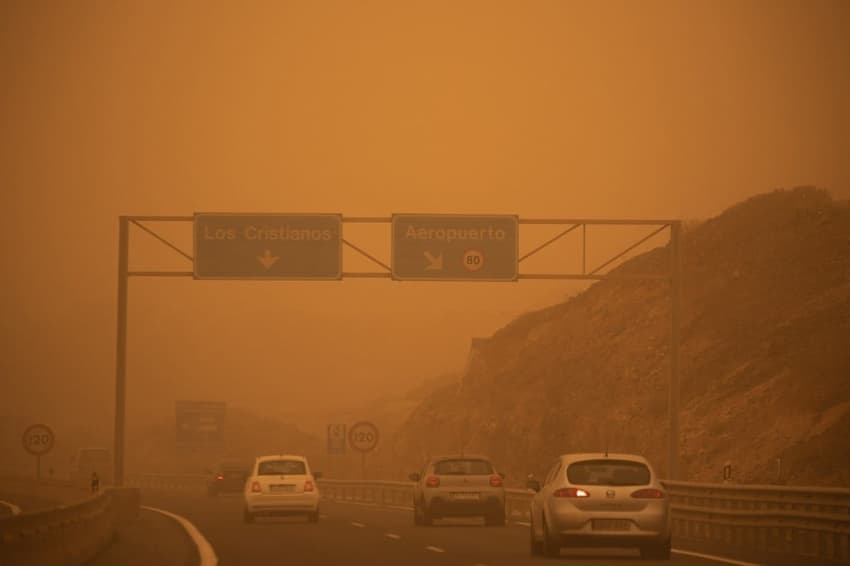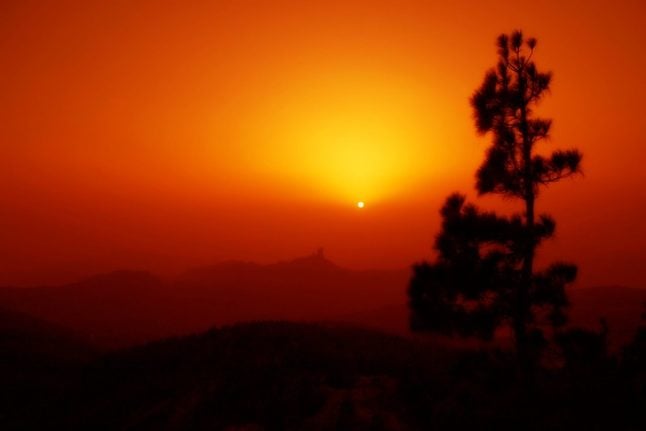Weather in Spain: What is 'calima' and is it bad for you?

If the sky in your part of Spain has turned yellow or orange, the visibility is poor and the air is stuffier, then it’s highly likely it’s calima. But what is this atmospheric phenomenon and is it bad for your health?
Much of Spain may enjoy clear blue skies for a large part of the year but there are places which sometimes look like a post-apocalyptic world where visibility is low and everything is dusty. This is known as calima.
What is calima?
Calima is the Spanish word used to describe when there’s sand or dust in suspension in the atmosphere. The English translation is haze.
There are two types of calima - type A calima refers to natural haze from sand, dust and other particles that come from the environment, whereas type B calima refers to the haze that comes as a result of pollution or ash from a forest fire for example.
Even though some of Spain’s bigger cities do often suffer poor air quality as a result of pollution, the most striking episodes of calima come as a result of huge sand clouds from the Sahara blowing over to the Spanish territory, given Spain’s relative proximity with the 9.2 million square kilometre desert.
Visibility is poor, the sky turns either yellow, orange or red, the air is usually drier and more stifling, it gets harder to breathe and everything is covered in a layer of dust.

A hazy sunset in Gran Canaria. Photo: El Coleccionista de Instantes/Flickr
Calima episodes tend to last between three and five days.
When rainfall occurs during a period of calima, it leads to muddy rain, known as lluvia de barro in Spanish, as dust and sand particles are dragged down by the rain to the surface.
Calima is often confused with Sirocco, but they aren't the same. Although they both come from the Sahara, Calima is usually more stifling, hot and contains dust, whereas Sirocco coming from the Sahara contains more moisture by the time it reaches southern Europe.
Where is there most calima in Spain?
Given the Canary Islands’s proximity to northwestern Africa (Fuerteventura is only 100km from the Moroccan coastline), the Atlantic archipelago experiences by far the most common episodes of calima in Spain.
Whenever there are sand storms in the Sahara or Sahel deserts and the trade winds blow south or east, the Canaries experience calima. This happens many times throughout the year, with varying degrees of severity.

A satellite image by Nasa shows how easy it is for the Canaries' most easterly islands to be affected by sand blowing over from the Sahara.
However, during adverse meteorological conditions and periods of extreme wind, it’s not uncommon for parts of the Spanish mainland including Andalusia, Murcia and the Valencia region to also be affected by calima.
During Storm Celia in March 2022, a huge cloud of suspended dust covered almost the entire Spanish mainland and the Balearic Islands and reached as far up as France, combining with a period of stormy weather to create mud rain.
Is calima bad for people’s health?
During periods of extreme calima, parts of Spain experience some of the worst air quality in the world.
Particles that measure less than 10 microns enter our body through the respiratory tract and reach the lungs and the blood.
The World Health Organisation (WHO) considers that a concentration of suspended dust higher than 50 milligrams per cubic metre can be harmful to people’s health.
Although a high concentration of PM10 particles isn’t good in general, short periods of exposure won’t be harmful to most people, apart from maybe causing some difficulty breathing, itchy eyes, a dry throat and potentially a cough.
However, for those with pre-existing respiratory conditions, asthma or allergies, calima can be problematic and cause problems such as bronchitis, chest pain or palpitations.
These people should aim to spend as little time as possible outdoors during periods of calima, and it’s advisable for them to wear a face mask if they do have to go out.
The general advice for everyone else is to close doors and windows (to keep their homes clean and prevent breathing the dust-filled air), avoid doing exercise outdoors, drink plenty of water and keep surfaces at home clean with a damp cloth.
Comments
See Also
Much of Spain may enjoy clear blue skies for a large part of the year but there are places which sometimes look like a post-apocalyptic world where visibility is low and everything is dusty. This is known as calima.
What is calima?
Calima is the Spanish word used to describe when there’s sand or dust in suspension in the atmosphere. The English translation is haze.
There are two types of calima - type A calima refers to natural haze from sand, dust and other particles that come from the environment, whereas type B calima refers to the haze that comes as a result of pollution or ash from a forest fire for example.
Even though some of Spain’s bigger cities do often suffer poor air quality as a result of pollution, the most striking episodes of calima come as a result of huge sand clouds from the Sahara blowing over to the Spanish territory, given Spain’s relative proximity with the 9.2 million square kilometre desert.
Visibility is poor, the sky turns either yellow, orange or red, the air is usually drier and more stifling, it gets harder to breathe and everything is covered in a layer of dust.

Calima episodes tend to last between three and five days.
When rainfall occurs during a period of calima, it leads to muddy rain, known as lluvia de barro in Spanish, as dust and sand particles are dragged down by the rain to the surface.
Calima is often confused with Sirocco, but they aren't the same. Although they both come from the Sahara, Calima is usually more stifling, hot and contains dust, whereas Sirocco coming from the Sahara contains more moisture by the time it reaches southern Europe.
Where is there most calima in Spain?
Given the Canary Islands’s proximity to northwestern Africa (Fuerteventura is only 100km from the Moroccan coastline), the Atlantic archipelago experiences by far the most common episodes of calima in Spain.
Whenever there are sand storms in the Sahara or Sahel deserts and the trade winds blow south or east, the Canaries experience calima. This happens many times throughout the year, with varying degrees of severity.

However, during adverse meteorological conditions and periods of extreme wind, it’s not uncommon for parts of the Spanish mainland including Andalusia, Murcia and the Valencia region to also be affected by calima.
During Storm Celia in March 2022, a huge cloud of suspended dust covered almost the entire Spanish mainland and the Balearic Islands and reached as far up as France, combining with a period of stormy weather to create mud rain.
Is calima bad for people’s health?
During periods of extreme calima, parts of Spain experience some of the worst air quality in the world.
Particles that measure less than 10 microns enter our body through the respiratory tract and reach the lungs and the blood.
The World Health Organisation (WHO) considers that a concentration of suspended dust higher than 50 milligrams per cubic metre can be harmful to people’s health.
Although a high concentration of PM10 particles isn’t good in general, short periods of exposure won’t be harmful to most people, apart from maybe causing some difficulty breathing, itchy eyes, a dry throat and potentially a cough.
However, for those with pre-existing respiratory conditions, asthma or allergies, calima can be problematic and cause problems such as bronchitis, chest pain or palpitations.
These people should aim to spend as little time as possible outdoors during periods of calima, and it’s advisable for them to wear a face mask if they do have to go out.
The general advice for everyone else is to close doors and windows (to keep their homes clean and prevent breathing the dust-filled air), avoid doing exercise outdoors, drink plenty of water and keep surfaces at home clean with a damp cloth.
Join the conversation in our comments section below. Share your own views and experience and if you have a question or suggestion for our journalists then email us at [email protected].
Please keep comments civil, constructive and on topic – and make sure to read our terms of use before getting involved.
Please log in here to leave a comment.